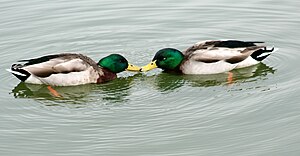
Back المثلية الجنسية في الحيوان Arabic Homosexualidá n'animales AST Gaweng homosekswal sa mga hayop BCL Cyfunrywioldeb mewn anifeiliaid Welsh Homoseksualitet blandt dyr Danish Homosexuelles Verhalten bei Tieren German Samseksemo ĉe bestoj Esperanto Comportamiento homosexual en animales Spanish Loomade homoseksuaalne käitumine Estonian رفتار همجنسگرایانه در جانوران Persian

Various non-human animal species exhibit behavior that can be interpreted as homosexual or bisexual. This may include same-sex sexual activity, courtship, affection, pair bonding, and parenting among same-sex animal pairs.[1][2][3] Various forms of this are found in every major geographic region and every major animal group. The sexual behavior of non-human animals takes many different forms, even within the same species, though homosexual behavior is best known from social species.
Scientists perceive homosexual behavior in animals to different degrees. A 2019 paper states that same-sex sexual behavior has been observed in over 1,500 species.[4] A previous 1999 book by Canadian biologist Bruce Bagemihl states same-sex behavior (comprising courtship, sexual, pair-bonding, and parental activities) has been documented in over 450 species of animals worldwide.[5]: 12 Although same-sex interactions involving genital contact have been reported in hundreds of animal species, they are routinely manifested in only a few, including humans.[6] Simon LeVay stated that "[a]lthough homosexual behavior is very common in the animal world, it seems to be very uncommon that individual animals have a long-lasting predisposition to engage in such behavior to the exclusion of heterosexual activities. Thus, a homosexual orientation, if one can speak of such thing in animals, seems to be a rarity."[7] The motivations for and implications of these behaviors are lensed through anthropocentric thinking; Bagemihl notes that any hypothesis is "necessarily an account of human interpretations of these phenomena".[5]: 2
One species in which exclusive homosexual orientation occurs is the domesticated sheep (Ovis aries).[8][9] "About 10% of rams (males), refuse to mate with ewes (females) but do readily mate with other rams."[9]
In October 2023, biologists reported studies of animals (over 1,500 different species) that found same-sex behavior (not necessarily related to human orientation) may help improve social stability by reducing conflict within the groups studied.[10][11]
- ^ Braithwaite, L. W. (1981). "Ecological studies of the Black Swan III – Behaviour and social organization". Wildlife Research. 8. Canberra, Australia: CSIRO: 134–146. doi:10.1071/WR9810135.
- ^ Bailey, N. W.; Zuk, M. (August 2009). "Same-sex sexual behavior and evolution". Trends in Ecology and Evolution. 24 (8): 439–46. doi:10.1016/j.tree.2009.03.014. PMID 19539396.
- ^ "Same-sex Behavior Seen In Nearly All Animals, Review Finds". ScienceDaily (Press release). 17 June 2009.
- ^ Monk, Julia D.; Giglio, Erin; Kamath, Ambika; Lambert, Max R.; McDonough, Caitlin E. (December 2019). "An alternative hypothesis for the evolution of same-sex sexual behaviour in animals". Nature Ecology and Evolution. 3 (12): 1622–1631. Bibcode:2019NatEE...3.1622M. doi:10.1038/s41559-019-1019-7. ISSN 2397-334X. PMID 31740842. S2CID 256708244.
- ^ a b Bagemihl B (1999). Biological Exuberance: Animal Homosexuality and Natural Diversity (Stone Wall Inn ed.). New York City: St. Martin's Press. ISBN 9780312253776 – via Internet Archive.
- ^ Bailey JM, Vasey PL, Diamond LM, Breedlove SM, Vilain E, Epprecht M (September 2016). "Sexual Orientation, Controversy, and Science". Psychological Science in the Public Interest. 17 (2): 45–101. doi:10.1177/1529100616637616. PMID 27113562. S2CID 42281410.
- ^ Levay S (1996). Queer Science: The Use and Abuse of Research into Homosexuality. Cambridge, Massachusetts: MIT Press. p. 207. ISBN 9780262121996.
- ^ Poiani A, Dixson AF (2010). Animal Homosexuality: A Biosocial Perspective. Cambridge University Press. p. 179. ISBN 9781139490382.
This makes O. aries (ram) only the second mammal known, apart from humans, capable of displaying exclusive homosexuality.
- ^ a b Levay S (2017). Gay, Straight, and The Reason Why: The Science of Sexual Orientation (Second ed.). Cambridge, Massachusetts: Oxford University Press. pp. 38, 119. ISBN 978-0-19-029737-4 – via Google Books.
- ^ Zimmer, Carl (3 October 2023). "Same-Sex Behavior Evolved in Many Mammals to Reduce Conflict, Study Suggests". The New York Times. Archived from the original on 20 October 2023 – via Internet Archive.
- ^ Gómez, José M.; et al. (3 October 2023). "The evolution of same-sex sexual behaviour in mammals". Nature. 14 (5719): 5719. Bibcode:2023NatCo..14.5719G. doi:10.1038/s41467-023-41290-x. PMC 10547684. PMID 37788987.
© MMXXIII Rich X Search. We shall prevail. All rights reserved. Rich X Search